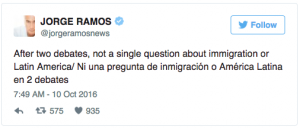Since the first pushes for immigration reform in the mid-1800s, immigration policy has increasingly become a core issue in American politics and Presidential elections. Perhaps that has never been more evident than in the 2016 election, as 70 percent of voters say immigration is a “very important factor” in their ballot decision this month.
But where along the way did immigration turn from a fact-based appeal to a more emotional one?
In 2013, evidence of the shift can be found in an appeal for immigration reform by President Obama: “This is not just a debate about policy, it’s about people… who want nothing more than a chance to earn their way into the American story.”
Although this appeal was made in conjunction with bipartisan efforts at immigration reform (an undeniably factual and economical subject of legislature), the language that President Obama used to explain his support was sentimental. He appealed to basic human and American values of inclusivity rather than employing rational argument to feed his particular immigration narrative.
Blanketing immigration issues with emotion is also evident in the 2016 election, especially with candidate Donald Trump. A man who poses himself as a savior to a nation in crisis, Trump’s campaign has been centered around hard-hitting immigration reform and building his infamous wall between America and Mexico.
His opinions are divisive and clear-cut. His processes for achieving his immigration proposals are little less so. So how is Trump’s rhetoric managing to gain traction with voters?
He is successfully appealing to Americans’ – especially conservative Americans – fears that our country isn’t safe. He uses immigrants as pawns and characters in his fear narrative, creating his own definition of them and their threat to “our country as we know it.” In the process, he’s generalized the issue of immigration and especially immigrants themselves. With this generalization, it becomes easier for Americans to turn to emotion rather than facts to make their ballot decision, because the issue has been condensed into a seemingly black and white decision, when it undeniably isn’t so.
Capitalizing on Americans lack of knowledge on the particulars of certain policy issues is nothing new, but with the help of modern media, it’s becoming increasingly easier to win votes based on emotional appeals that are backed with little rational substance.
At our core, humans are emotional beings. As Drew Westen notes in The Political Brain, “In politics, when reason and emotion collide, emotion invariably wins.” This is particularly illustrated with Trump’s immigration narrative in 2016.



